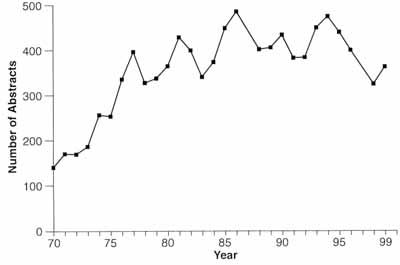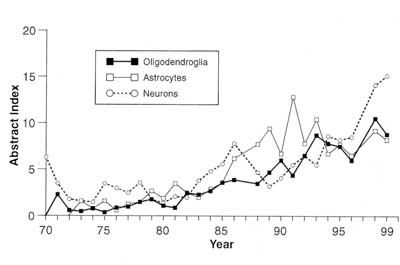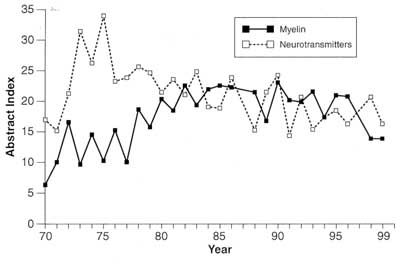Was the ASN a "Myelin Club" ? - Marion E. Smith |
- Home
- About The ASN
- History
- Oral History by Dr. Marion Smith
C.F.B.: Early in the life of the Society, there was an often repeated rumor flying around, primarily among non members, that the American Society for Neurochemistry was predominantly a "myelin club". Marion Smith, our next speaker was sufficiently interested in this rumor to take time out and test its validity in an objective, scientific manner. Here is her report:
For many years a perception existed, not only with neurobiologists outside the ASN, but also with those within the Society that were not in the myelin field, that the ASN was becoming a myelin club. At the time of the early meetings, the Society for Neuroscience had just formed, but for at least the first ten years, very little myelin work was presented at the Society for Neuroscience meetings. Almost all work presented concerning myelin and myelin diseases was concentrated within the ASN. It is true that a large amount of myelin work was presented, and that some of the most important breakthroughs in the myelin field came from the platforms of our meetings. I, however, as a myelin researcher, never felt that this subject predominated our meetings. There were many other areas of neuroscience research presented, both in oral sessions and symposia.
The organizing committee that founded the ASN was composed of twelve people, four of which worked in the myelin field, namely Jordi Folch-Pi, Guy McKhann, Francis LeBaron, and Fred Wolfgram. At the first ASN meeting in Albuquerque, there were only nine papers on myelin, out of a total of 141 abstracts. The subject with the most papers was non-myelin lipids, with a total of 22, and these included ganglioside structure, the metabolism of brain lipids, and lipids in relation to leukodystrophies.
When I retired a few years ago, I gave or threw away many books and journals, but for some reason, I kept all thirty volumes of the Transactions of the ASN. So, when Claude suggested that I might look into the "myelin club" issue, I was well armed. I thought it would be interesting to go back over the thirty years of abstracts to see just which subjects were covered, and whether myelin really predominated. I decided to do this by finding a basic neurochemical subject, and for this I chose neurotransmitters to compare with myelin. It was a difficult task to determine just which abstracts were primarily related to myelin, and I decided to count those that were about myelin lipids, myelin protein, myelin structure, and the expression molecules of the myelin proteins, as well as EAF, MS, and any paper about peripheral nerve myelin, such as the proteins, lipids, and Wallerian degeneration. For neurotransmitters, I included the abstracts about acetylcholine, serotonin, GABA, and glutamic acid in relation to its transmitter properties. Also included were the transmitter receptors and their expression molecules.
One problem was that the number of abstracts varied greatly from year to year, with a low of 141 in Albuquerque in 1970, to a high point of 486 in Montreal in 1986 (Figure 1).

There was a big dip in Denver in 1999, and undoubtedly at this meeting in Chicago (2000) the number will rise (it did, to 397). Joint meetings with the International Society were not counted. To normalize the number of abstracts presented, an abstract index was devised where the number of abstracts in any subject were divided by the total number of abstracts at that meeting, and multiplied by 100 to obtain whole numbers. This somewhat lessened the great variation from year to year. The results comparing neurotransmitter abstracts with those about myelin showed that the neurotransmitter abstracts greatly predominated for the first ten years (Figure 2).
|
This was the heyday of catecholamines and acetylcholine. Of those about myelin, only 9 were presented in the first year, and the numbers went up and down in subsequent years. The attempt to normalize the numbers did not smooth out the curve. If there were a large number of papers in one category in a given year, there was inevitably a respite in the next year, followed by another surge, etc. After 1984 the numbers of neurotransmitter papers ran about even, overall, with the myelin papers, but at no time did myelin ever predominate over neurotransmitters, and of course there were many other subjects covered besides these two.It was also of interest to compare the numbers of papers on the various kinds of neural cells. If oligodendrocytes were more interesting than neurons or astrocytes, this might reflect an undue emphasis on myelin. When the papers on these three kinds of cells were compared, it was surprising to find that for the first three years there were no astrocyte papers, and neurons predominated (Figure 3).

In those days it was not possible to separate the kinds of glia, and I did not count the papers about "glia" or "glioma", or C6 cells. But with the help of GFAP, many more kinds of experiments were possible, and for a time astrocytes predominated. At this time the neurons are taking off again. But oligodendrocytes never did predominate in spite of the seemingly endless numbers of papers on oligodendrocyte lineage. So, again, these comparisons did not support the perception that myelin rules the ASN.
So why did this perception come about? I think it was because the myelin sessions were quite visible. A number of colorful characters who were very possessive of their own findings were involved. Although, at the first ASN meeting in Albuquerque there was no myelin session, the stage had already been set. About six years earlier at a New York Academy of Science meeting which I and others in this room attended, a lot of myelin work was presented for the first time. Bill Norton reported on a method for purifying myelin, and presented a lipid composition for this structure. Marian Kies also reported another myelin purification method, and also a lipid composition, Marjorie Lees described her studies with the proteolipid protein, and this was all very friendly. Three different people, however, E.J. Fields, Marian Kies' laboratory, and Elizabeth Roboz-Einstein reported the partial purification of an encephalitogenic protein which was extractable in 0.1 N HCl. They all appeared to have the same protein, but in different stages of purification. There was much argument about dialysis time, and "what do you mean by dialyzable?", and other details, and some of the remarks were not very polite.
In the next six years the proteins became much better purified, but at the Albuquerque meeting, where there was no myelin session, a new character appeared on the scene, Ed Eylar. In a protein session he described a new protein which he called A1. It was encephalitogenic, and was fairly pure. If, however, the tryptophane group was blocked, the encephalitogenic activity was blocked. This work was presented as if the A1 was a new protein, with no attempt to relate his protein to that already described in the literature. Needless to say, this was quite irritating.
At the next ASN meeting in Hershey,where there was a myelin session, Ed was not in it. Instead, at a protein session he reported the complete sequence of his A1 protein, which was especially irritating, because he had beaten everyone else to it. Over the years, many others jumped into fray of myelin basic protein (MBP) as it came to be called, including Steve Brostoff, George Hashim, Fred Wolfgram, Bob Kibler, and Catherine McPherson, and later on, in the proteolipid protein (PLP) field, originally dominated by Jordi Folch-Pi and Marjorie Lees, there were Mario Moscarello, and John Trotter. The myelin basic protein sessions were especially wild. There was much discussion about who discovered the protein, who purified it first, how pure it was, as well as whether MBP in imcomplete adjuvant would protect against subsequent immunization with complete Freund's adjuvant. The discussions were stormy, critical, and very rude, with insults hurled around the room. Sometimes it was a bit embarrassing to the non-participants in the controversies.
For a while it was thought that the proteins PLP and MBP were the main proteins in myelin. The Wolfgram Protein was added shortly after, which was found subsequently by Terry Sprinkle to contain enzymatic activity, as well as other constituents. Then Dick Quarles found and described a new protein which he called the myelin-associated glycoprotein (MAG). He had a difficult time getting his findings accepted because it had already been published by Ed Eylar that there were no glycoproteins in myelin. Then when Dick, in company with Jean-Marie Matthieu found two forms of the MAG it was almost too much. Even Marjorie Lees did not escape critical comment. When her group showed that the PLP was encephalitogenic, it was widely disbelieved, and was said to be due to contaminating MBP in the preparation. It wasn't until her group identified the encephalitogenic peptide, synthesized it, and injected it into an animal which developed EAE, that her critics were finally convinced that her PLP was not contaminated with MBP.
So why was this such a big deal? Why were the workers in the myelin field so emotional? At that time it was, and still is, terribly important to solve the problem of multiple sclerosis, and at the time it was not realized how very complex multiple sclerosis as well as EAE are. At first, everyone thought that MBP was the key to MS, and if MBP was manipulated in certain ways, MS could be cured. Naturally everyone wanted to be the one who succeeded. So, here we are, thirty years later, with hundreds of millions of dollars spent by the NIH and the MS Society, and the cure for MS, though much closer, is not yet at hand. I think, however, that our members have contributed greatly to the unraveling of the mysteries of myelin and to a better understanding of MS. Many of the breakthroughs have been announced on our platforms, and certainly this meeting is no exception. Myelin papers are still coming on, and we hope, due to our meetings, we will reach a much better understanding of the field, maybe better treatments, or even a cure. Certainly there is much potential out there.

